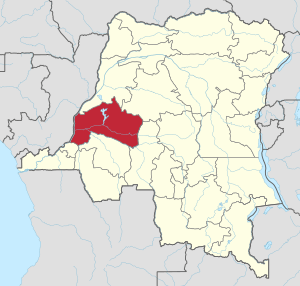Mai-Ndombe Province facts for kids
Quick facts for kids
Mai-Ndombe Province
|
|
|---|---|
|
Province
|
|

Lake Maï Ndombe
|
|
 |
|
| Country | |
| Capital | Inongo |
| Area | |
| • Total | 127,465 km2 (49,215 sq mi) |
| Population
(2005 est.)
|
|
| • Total | 1,768,327 |
| • Density | 13.87304/km2 (35.93101/sq mi) |
| Official language | French |
Mai-Ndombe Province is one of the 26 provinces in the Democratic Republic of the Congo. It is located in the western part of this large African country. The capital city of Mai-Ndombe Province is Inongo. This province is known for its big lake, Lake Maï Ndombe, which is a very important natural feature.
Contents
About Mai-Ndombe Province
Mai-Ndombe Province is a region in the Democratic Republic of the Congo. It was created in 2015 when the country reorganized its provinces. Before that, it was part of a larger province called Bandundu. The province gets its name from the large lake, Lake Maï Ndombe, which means "black water" in some local languages.
Geography and Location
Mai-Ndombe Province is a large area, covering about 127,465 square kilometers. This is roughly the size of a country like Greece or Nicaragua. It is located in the central-western part of the Democratic Republic of the Congo. The province shares borders with several other provinces, including Équateur Province to the north and Kwilu Province to the south.
The landscape of Mai-Ndombe is mostly flat, with many forests and swamps. The most important natural feature is Lake Maï Ndombe. This lake is one of the largest in Africa and plays a big role in the lives of the people who live nearby. Many rivers also flow through the province, helping with transport and providing water.
People and Culture
In 2005, the population of Mai-Ndombe Province was estimated to be around 1.7 million people. Many different ethnic groups live in the province, each with their own unique traditions and languages. The official language of the province, like the rest of the Democratic Republic of the Congo, is French. However, many local languages are also spoken, with Lingala being one of the most common.
The people of Mai-Ndombe often rely on farming and fishing for their livelihoods. They grow crops like cassava, maize, and plantains. Fishing in Lake Maï Ndombe is also a major activity. The culture is rich with music, dance, and storytelling, reflecting the diverse communities that call this province home.
Capital City: Inongo
The capital city of Mai-Ndombe Province is Inongo. It is located on the eastern shore of Lake Maï Ndombe. Inongo is the main administrative and commercial center for the province. It is where the provincial government is based.
Life in Inongo is closely connected to the lake. Boats are a common way to travel and transport goods. The city has markets where people can buy and sell local products, including fish from the lake. While it is the capital, Inongo is not a very large city. It has a more relaxed, rural feel compared to bigger cities in the country.
Economy and Resources
The economy of Mai-Ndombe Province is mainly based on natural resources. Farming is very important, with many families growing food for themselves and to sell. Fishing in Lake Maï Ndombe provides a lot of food and income for the local communities.
The province also has large areas of forest. These forests contain valuable timber, which is sometimes harvested. However, efforts are made to ensure that logging is done in a way that protects the environment. Other resources might include palm oil and rubber, which are grown in some areas. Transporting goods can be challenging due to the lack of good roads, so rivers and the lake are crucial for trade.
See also
 In Spanish: Provincia de Mai-Ndombe para niños
In Spanish: Provincia de Mai-Ndombe para niños

